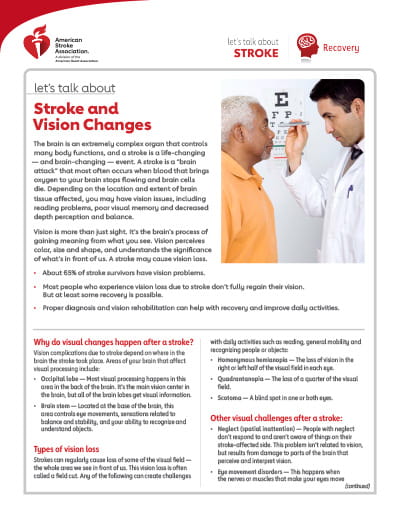Let’s Talk About Stroke and Vision Changes
 The brain is an extremely complex organ that controls many body functions, and a stroke is a life-changing — and brain-changing — event. A stroke is a “brain attack” that most often occurs when blood that brings oxygen to your brain stops flowing and brain cells die. Depending on the location and extent of brain tissue affected, you may have vision issues, including reading problems, poor visual memory and decreased depth perception and balance.
The brain is an extremely complex organ that controls many body functions, and a stroke is a life-changing — and brain-changing — event. A stroke is a “brain attack” that most often occurs when blood that brings oxygen to your brain stops flowing and brain cells die. Depending on the location and extent of brain tissue affected, you may have vision issues, including reading problems, poor visual memory and decreased depth perception and balance.
Vision is more than just sight. It’s the brain’s process of gaining meaning from what you see. Vision perceives color, size and shape, and understands the significance of what’s in front of us. A stroke may cause vision loss.
- About 65% of stroke survivors have vision problems.
- Most people who experience vision loss due to stroke don’t fully regain their vision. But at least some recovery is possible.
- Proper diagnosis and vision rehabilitation can help with recovery and improve daily activities.
Why do visual changes happen after a stroke?
Vision complications due to stroke depend on where in the brain the stroke took place. Areas of your brain that affect visual processing include:
- Occipital lobe — Most visual processing happens in this area in the back of the brain. It’s the main vision center in the brain, but all of the brain lobes get visual information.
- Brain stem — Located at the base of the brain, this area controls eye movements, sensations related to balance and stability, and your ability to recognize and understand objects.
Types of vision loss
Strokes can regularly cause loss of some of the visual field — the whole area we see in front of us. This vision loss is often called a field cut. Any of the following can create challenges with daily activities such as reading, general mobility and recognizing people or objects:
- Homonymous hemianopia — The loss of vision in the right or left half of the visual field in each eye.
- Quadrantanopia — The loss of a quarter of the visual field.
- Scotoma — A blind spot in one or both eyes.
Other visual challenges after a stroke:
- Neglect (spatial inattention) — People with neglect don’t respond to and aren’t aware of things on their stroke-affected side. This problem isn’t related to vision, but results from damage to parts of the brain that perceive and interpret vision.
- Eye movement disorders — This happens when the nerves or muscles that make your eyes move are damaged. Examples in stroke survivors include rhythmic eye movements (nystagmus), misaligned eyes (strabismus), eye tracking control issues (oculomotor dysfunction) and double vision (diplopia). Your depth perception, balance, coordination and overall vision may be affected.
- Dry eyes — Some survivors have trouble blinking or fully closing their eyes, and the eyes don’t stay moist enough. When this happens, dry eyes can develop, causing irritation, burning or blurry vision.
How can I manage these changes?
Eye doctors (ophthalmologists and optometrists), brain doctors (neurologists) and brain-eye doctor specialists (neuro-ophthalmologists and neuro-optometrists) can diagnose vision problems and develop a treatment plan. These plans may involve a variety of rehabilitation therapies and often have a goal of helping survivors compensate for losses and regain as much function as possible. Examples of therapies include:
- Scanning — One of the most common types of visual therapies, it helps train the eyes to better scan toward and away from areas of vision loss.
- Prisms — They can be added to your glasses to change the way you perceive certain objects in space by changing the direction of incoming light.
- Relaxation and breathing techniques.
- Spatial awareness and balance activities.
How can I learn more?
- Call 1-888-4-stroke (1-888-478-7653) or visit stroke.org to learn more about stroke or find local support groups.
- Sign up for the Stroke Connection, a free magazine for stroke survivors and caregivers, at StrokeConnection.org.
- Connect with others sharing similar journeys with stroke by joining our Support Network at stroke.org/SupportNetwork.
Do you have questions for your doctor or nurse?
Take a few minutes to write down your questions for the next time you see your health care provider. For example:
What tools or therapies can help me with my vision challenges?
We have many other fact sheets to help you make healthier choices to reduce your risk, manage disease or care for a loved one. Visit stroke.org/LetsTalkAboutStroke to learn more
© Copyright 2023 American Heart Association, Inc., a 501(c)(3) not-for-profit. All rights reserved. American Stroke Association is registered trademark of the AHA. Unauthorized use prohibited. WF277238 7/23